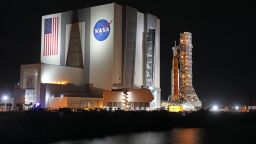Editor’s note: Don Lincoln is a senior scientist at the Fermi National Accelerator Laboratory. He is the author of several science books, including the audio book “The Theory of Everything: The Quest to Explain All Reality.” He also produces a series of science education videos. Follow him on Facebook. The opinions expressed in this commentary are his own. View more opinion on CNN.
According to the venerable television show “Star Trek,” space is the final frontier. While the challenges of human space travel are daunting, if people can successfully colonize first the solar system and then the stars, our future is bright — brimming with limitless resources.

We have begun the process of exploring the solar system, launching unmanned probes to lead the way. The images they beam back to us from distant planets gives us a taste of the wonders we will encounter. However, there is a problem. The network that connects us to those technological eyes is in trouble.
The Deep Space Network, or DSN, is an interconnected set of three radio telescope facilities spread across the globe. These installations, located in California, Spain and Australia, are managed and operated for NASA by the Jet Propulsion Laboratory. At about 120 degrees apart in longitude, their locations were selected so that any space probe at a distance greater than 30,000 kilometers (about 18,640 miles) from Earth can be in radio contact with at least one of them.
DSN is the main way that NASA contacts spacecraft far from Earth, including such technical marvels as the James Webb Space Telescope, the Mars 2020 Perseverance rover and even ultra-distant Voyager 1 probe — the manmade object that is currently farthest from Earth. Indeed, without the DSN, NASA’s robotic exploration of deep space would simply not be possible.
The problem with the DSN is multifold. While it has performed brilliantly since it began operations in the 1960s and has experienced periodic upgrades, it is overtaxed and in critical need of infrastructure improvements.
There are currently 40 missions that rely on the DSN antennas to operate, with the expectation that an additional 40 missions will be launched in the future. Given that some of the existing missions will still be functional, the demands on the network will continue to grow.
The severity of the situation was made starkly evident during the recent NASA Artemis I mission to the moon. Although this mission was unmanned, the Artemis program will eventually lift astronauts in a spacecraft called Orion into space, with plans to land humans on the moon as soon as 2025. The DSN will be the method whereby mission controllers on Earth will communicate with astronauts and monitor the trajectory of the craft.
During the Artemis I mission, the DSN was used to track the unmanned Orion capsule. The capsule was accompanied by 10 small secondary “CubeSats,” which are tiny satellites that range in size from about the size of a toaster to the size of a briefcase. Essentially, they are inexpensive devices that can perform specific tasks.
However, each of those CubeSats required its own DSN link for Earth-bound technical staff to monitor its performance, which imposed a heavy load on the capabilities of the communication network. Indeed, during the 25-day-long Artemis I mission, other science-critical missions were neglected.
To give a sense of the impact, the Orion spacecraft received 903 hours of DSN time, while the CubeSats consumed an additional 871 hours of DSN time.
During the Artemis flight, the use of DSN meant that important science missions were denied 1,585 hours of the use of the network, including 185 hours that the James Webb Space Telescope could not communicate with Earth. In addition, while the Orion spacecraft was in flight, NASA deferred 509 hours of important DSN maintenance.
This is not to say that the Artemis mission is unimportant. On the contrary, if humanity is going to once again venture into deep space, it will be crucial to be able to maintain a radio link with those intrepid explorers. And the need for additional capability to interact with unmanned deep space probes grows, both because of additional missions and due to the simple fact that modern cameras make sharper images and require faster connectivity to transmit the images.
Essentially, it is no different than how your high-definition television streaming requires more bandwidth than older standard definition. As was reported in a recent inspector general report, the current situation is untenable and will only get worse.
So, what is to be done? Most importantly, we should listen to the communication professionals running the DSN and give them the support necessary to enhance their capabilities. This can include building additional antennas at the three DSN sites, improving the electronics on current antennas and a variety of additional upgrades.
The operational costs of upgrading DSN are relatively modest. For a cost of a few hundred million dollars, the DSN facilities can be refurbished and upgraded. This is minimal compared with the $10 billion cost of the James Webb Space Telescope and the Artemis mission, which is likely to cost more than $40 billion over five years.
Both of those missions, indeed all deep space programs, depend on reliable communication, or they will fail. It is imperative that we fund the communication network that will allow these efforts to succeed.
If we are to explore the universe around us, we must be able to communicate with those brave souls who venture out into the final frontier — both human and robotic. The Deep Space Network is NASA’s link to the planets, and it needs additional support if we ever hope to boldly go where no one has gone before.






